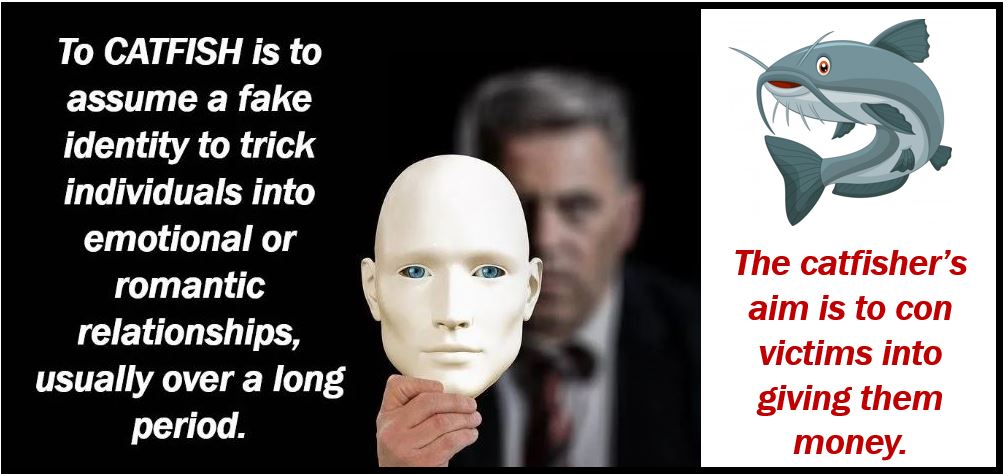What is Catfishing? Definition and examples
Catfishing is a fraudulent activity in which somebody creates a fake identity on a social networking platform. Typically, the perpetrator targets a specific individual for fraud or abuse.
Some con merchants assume a fake identity to trick victims into romantic or emotional relationships. These relationships can last for a very long time. The ultimate aim of the perpetrator is to extract money by deception, i.e., con the victim.
Often, these individuals will meticulously create backstories and social circles online that lend an air of legitimacy to their fabricated personas.

For scammers to be successful, they must not meet up with their victims. If they did, their con would be ruined.
We call somebody who engages in catfishing a catfish.
Metro.co.uk says the following about the term:
“A catfish may steal someone else’s photos, videos or personal information to create a fake profile or website when they’re forming their bogus identity. Usually they invent a name or base the identity on someone they used to know.”
“The ultimate aim of a catfish is, nine times out of ten, to extract money or personal details from the victim, as in the email scam called phishing.”
Signs of possible catfishing
- The writer makes spelling or grammar mistakes which a native speaker would not make.
- They ask for money.
- Some of their stories are very elaborate.
- The relationship rapidly develops into a romantic one – perhaps too quickly.
- They claim to be extremely ill or are suffering in some other way.
- You can never communicate with them by phone or via a webcam.
- They have either no or few friends in their social media platform.
- They do not have a permanent address because of their job.
- It all seems too good to be true.
If you spot any of these catfishing red flags, either in your relationship or of somebody you know, take action immediately.
Some online services such as socialcatfish.com can help you determine whether the other person is genuine or a scammer.
In one of our previous articles, I explained that catfishing is on the rise worldwide. Not only should you be alert for such scammers for yourself and friends, but also your children.
The emotional repercussions for individuals who have been deceived can be profound, often leading to long-term trust issues and psychological distress.
Online crime (cybercrime)
Since the advent of the Internet, the number of online criminals or scammers has increased dramatically. Let’s have a look at some examples of cybercrimes:
-
Phishing
The fraudulent practice of sending emails purporting to be from reputable companies to induce individuals to reveal personal information, such as passwords and credit card numbers.
For example: “She received an email that appeared to be from her bank, but it turned out to be a phishing attempt to steal her account details.”
-
Identity Theft
The deliberate use of someone else’s identity, typically to gain a financial advantage or obtain credit and other benefits in that person’s name.
For example: “After his social security number was stolen, he became a victim of identity theft, with several credit cards opened fraudulently in his name.”
-
Spoofing
The act of disguising communication from an unknown source as being from a known, trusted source, often used in conjunction with phishing or for malicious reasons.
For example: “Hackers were spoofing the company’s customer service email to send malware to unsuspecting clients.”
-
Online Scams
Deceptive schemes performed on the internet, often through fake websites or fraudulent offers, intended to defraud users.
For example: “She thought she had won a lottery via an online contest, but it was actually an online scam to get her bank details.”
-
Social Engineering
The psychological manipulation of people into performing actions or divulging confidential information, a tactic often used in various cybercrimes.
For example: “The cybercriminal used social engineering to trick the employees into revealing their passwords.”
-
Ransomware
A type of malicious software designed to block access to a computer system until a sum of money is paid.
For example: “The hospital’s computer systems were crippled by a ransomware attack, demanding payment to restore access to critical patient records.”
Video – What is Catfishing?
In this visual guide presented by our affiliate channel, Marketing Business Network on YouTube, we explain what “Catfishing” is using straightforward language and easy-to-understand examples.

